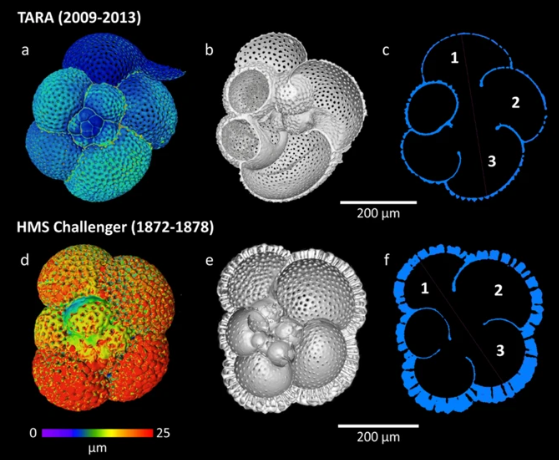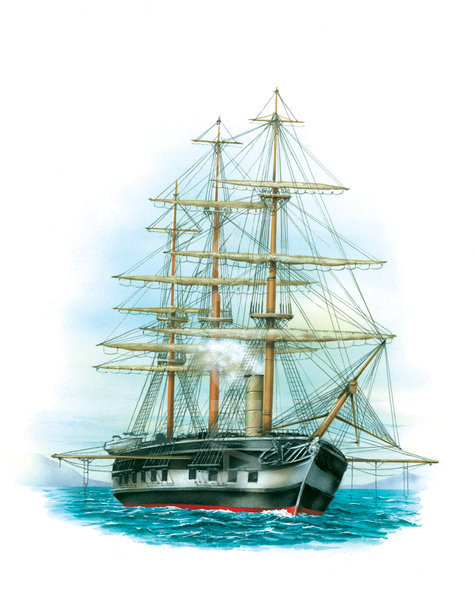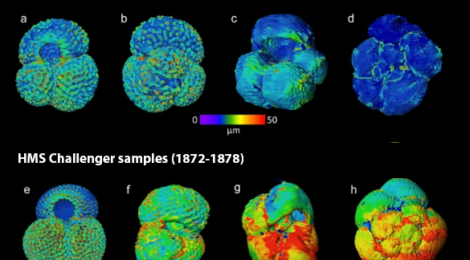
Old And Newly Collected Plankton Reveals An Ocean Catastrophe
HMS Challenger Sailed The World 1872-76 Following A Refit That Hammered Its Cannons Into Ocean Science Plowshares
Sailing over 70,000 miles in the greatest ocean science voyage ever
Its collections were meant to fill scientific archives and museums, and that they did
Now 150 years later those collections are revealing how healthy and abundant the oceans once were, but are no more. We must and we can restore the ocean plankton pastures
In a new scientific paper that has honored the famous Challenger Expedition by adding to its importance in the world of science, researchers have published in the Journal Nature on the ocean catastrophe of acidic thinning of shells of tiny plankton. In painstaking careful measurements of old and new specimens, the researchers report observations noone dared imagine would be so dire.
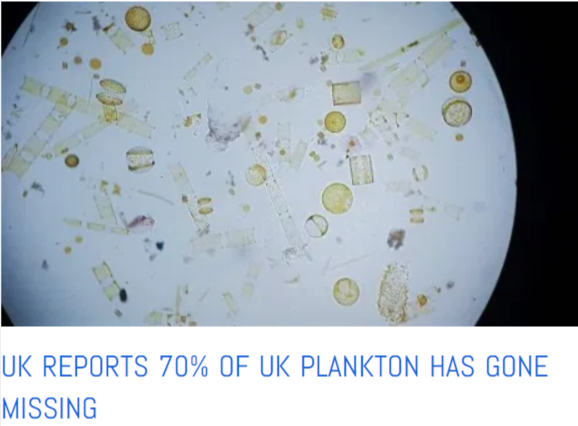
Reported in January UK ocean scientists declared an ocean pasture emergency as 70% of UK plankton the foundation of the ocean food chain has gone silently missing beneath waves. Click to read more
The culprit in this ocean crisis is the high and rising CO2 from our fossil fool age. While most have heard that CO2 is creating climate change, its effect on the climate of this blue planet pales in comparison to the massive toll it is taking in its more powerful role of inducing ocean change. Yesterday’s CO2 has been changing once flourishing ocean pastures into clear blue lifeless ocean deserts.
Lyndsey Fox, a researcher from Kingston University in London, analyzed plankton fossils gathered by the 1872–76 expedition of the HMS Challenger. It was research that required endless hours peering through microscopes to examine and measure tiny micro-fossils. The task was to create a record of how thick the shells are and then using a state of the art tomography scanner to create 3D models of their shells. None are more than 1 millimeter in diameter. Fox and colleagues persevered and built stunning reconstructions of century-old plankton. They then did the same thing for plankton gathered from a 2011 expedition to the eastern equatorial Pacific Ocean called Tara.
The result has revealed that today specimens of the identical species collected from the same locations have up to 76% thinner shells than those collected from by HMS Challenger 150 years ago. All modern plankton had much thinner shells in many cases, the shells were so thin that the team wasn’t even able to image them.
Its an ocean catastrophe
“Whilst all specimens analyzed showed some reduction in shell thickness, the degree to which different species responded varied greatly,” the authors of the study write.
“It’s a shocking result. Researchers were well aware that ocean acidification was taking a toll, but the extent to which this was observed is concerning.”
The Challenger Expedition was fostered by Charles Wyville Thomson—of the University of Edinburgh and the Royal Society of London. They obtained HMS Challenger from the Royal Navy and in 1872 and massively refitted the ship for scientific tasks, equipping her with separate laboratories for natural history and chemistry.
The ship traveled nearly 70,000 nautical miles (130,000 km; 81,000 mi) surveying and exploring worlds oceans. Among countless discoveries and collections, they cataloged over 4,000 previously unknown species. John Murray, who supervised the publication, described the report as “the greatest advance in the knowledge of our planet since the celebrated discoveries of the fifteenth and sixteenth centuries”.
More than plankton is endangered
It’s not just the microscopic plankton suffering in this ocean catastrophe. There are endless reports of the collapse of fisheries around the world. The standard refrain is that it must be ‘the usual suspects’ those bad overfishing greedy fishermen. Few dare to lay the blame on the collapse of ocean pastures that can no longer sustain their livestock. No one on land in the face of a terrible collapse of pastures that were seen to no longer be green and lush with grass would blame the missing livestock on over-harvesting.
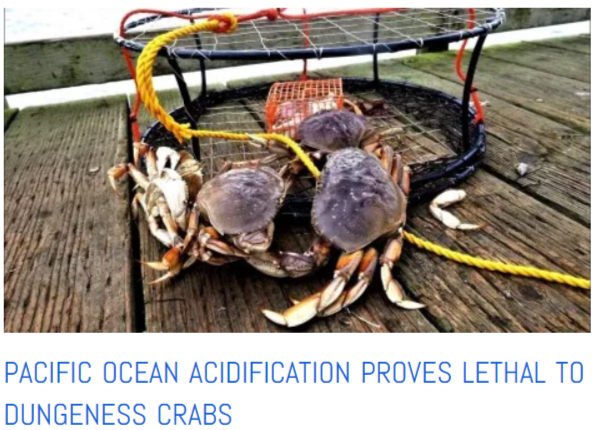
The Pacific Ocean has become so acidic due to high and rising levels of CO2 in the atmosphere that crab larvae are dissolving rather than growing. The study was published on January 22 in the journal Science of the Total Environment. – Click to read more
A recent study found that ocean acidification is also destroying the shells of crabs, and while some creatures might take it better than others, no creature is spared from its effects. When the plankton suffers, the entire ocean food chain suffers.
Ocean acidification is even far more immediate and dangerous that global warming. But today almost every report on it forces it to be subservient to climate change. It seems it is only politically correct to heap every environmental ill into one basket.
Even worse as the authors and editors of Nature have done in this report they try to use this ocean CO2 problem that derives from the trillion tonnes of CO2 already emitted into the air in all of the yesterday’s of the fossil fool age as needing to be cured by reducing emissions of tomorrow.
There is reason for hope
There is hope however that ocean acidification might be beaten back by the Nature-based solution of ocean pasture restoration, OPR. Our fossil CO2 dissolves into ocean waters readily. When it does the natural chemistry adds CO2 + H2O to make H2CO3, that’s carbonic acid the stuff that is melting the plankton, baby crabs and other shellfish.
The ONLY means to neutralize this inevitable acid is by restoring the health and abundance of our ocean pastures. Those pastures sustain the phytoplankton, the grass of the sea. When healthy and abundant phytoplankton uses the power of the sun through photosynthesis to compete with the H2O for that CO2. They always win and convert that acid-forming CO2 into ocean plankton the very thing that feeds larval crabs and shellfish, everything.
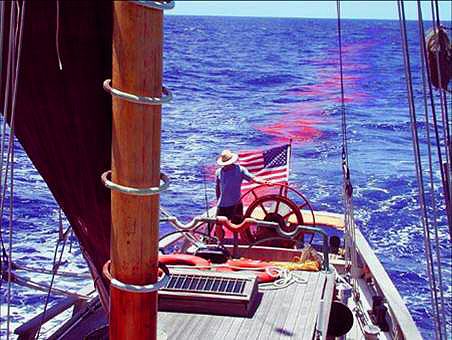
That’s me steering the 150 year old sailing schooner Ragland, loaned to me by friend Neil Young, so that I might test how replenishing natural hematite iron ore rock dust to replenish the natural dust we have denied the oceans by anthropogenic CO2. Click to read more
The only means to neutralize this inevitable acid is by restoring the health and abundance of our ocean pastures. Those pastures sustain the phytoplankton, the grass of the sea.
When in abundance ocean phytoplankton pastures feed all of ocean life by repurposing our deadly CO2 into new life itself. You can read everywhere on this blog how we have proven we can restore ocean pastures and save our seas from our sins of emissions.
Join me!
“Twenty years from now you will be more disappointed by the things that you didn’t do than by the ones you did do. So throw off the bowlines. Sail away from the safe harbor. Catch the trade winds in your sails. Explore. Dream. Discover.” Mark Twain









